HAMSTRING SAFETYHamstring injuries can cause an athlete to miss a game or a whole season. Hamstring injuries in the off-season can ruin progress for weeks. Injuries to the hamstring area have caused team losses in<By Bigger Faster Stronger Published: Spring 2001 When I see a hamstring injury, two thoughts immediately cross my mind: One, the athlete or coach simply did not know how to prevent this injury or two, the athlete refused to do what he/she was supposed to do. Important Tip: Many hamstring injuries occur when doing sprinting drills or sprinting for time. It is safer to run on a track surface than grass. Sprinting on soft grass will put bigger, faster athletes at risk. HOW TO PREVENT THE PROBLEM Injury prevention for the hamstrings depends on two factors. First, you must make all three hamstring muscles, from origin to insertion, very strong. Second, you must develop great flexibility by rigorous stretching of the hamstring muscles and tendons. The hamstrings consist of three powerful muscles in the back of the upper thigh: the Biceps Femoris, the Semitendinosus and the Semimembranosus (Graphic 1). The following section describes six exercises that have proven to be highly effective in preventing hamstring injuries. They are all considered as essential exercises in the BFS Total Program. I believe if athletes do these exercises all year long with great technique, then they could expect to be hamstring injury free! HAMSTRING EXERCISES Leg Curls (Picture 1): This exercise is perhaps the most common exercise done by athletes to strengthen the Hamstrings. However, just doing Leg Curls is far from the answer to hamstring injury prevention. They are done twice per week with two to three sets of ten repetitions. Jerking is prohibited. Leg Curls should be done in a slow and controlled manner. They also help strengthen the knee joint area. This is considered a medium-priority auxiliary exercise. Straight Leg Dead Lifts (Picture 2): Straight Leg Dead Lifts (SLDL) have a dual purpose of stretching and strengthening the Hamstrings and the Glutes at the same time. Straight Leg Dead Lifts should only be done with light weight. High school to pro athletes should use between 65-95 pounds and then progress slowly to no more than 135 pounds. The maximum for advanced lifters is 40% of their Parallel Squat max. Do this exercise in a very slow and controlled manner with the chin up and knees locked as shown in Picture 2. Do two to three sets of ten repetitions, two to three times per week. The Straight Leg Dead Lift should be a high-priority auxiliary exercise. It will also help you run faster and jump higher and will strengthen your lower back. Glute-Ham Raise (Picture 3): This exercise is done on a special machine called the Glute-Ham Developer, as shown in Picture 3. It strengthens the entire Hamstring muscle area from origin to insertion. Do at least two sets of ten repetitions at least twice per week. You can do up to twenty-five reps on this exercise with good results. This is more important than Leg Curls for the Hamstrings. Consider the Glute-Ham Raise to be a top-priority auxiliary exercise, which can also help strengthen the calf muscles and the lower back. In addition, the Glute-Ham Raise can help an athlete run faster and jump higher. Lunges (Picture 4): Take a long step as shown in Picture 4 when doing “Athletic” Lunges. This type of Lunge develops “Power Balance”. Do at least two sets of ten repetitions twice per week. Do not lean forward, but “be tall” with the lower back locked-in tight and with the eyes focused straight ahead. The back knee should be about one inch from the floor for best results. A straight bar or dumbbells may be used. Do Standard Lunges (return to original position) once per week and the other day of the week do Walking Lunges. This is a high-priority auxiliary exercise. Hamstring Stretch (Picture 5): The BFS One-On-The-Bench exercise is the best Hamstring stretch. This can be done on a bench, couch or with a team in the bleachers. Be tall with the stretch leg in front. The leg should be straight with the knee locked. The foot should be perfectly straight with the toes brought back not forward. Try to lock-in the lower back and look straight ahead. Now, pull your entire body forward. Do not try to put your chin on your knee. Do this hard with intensity for a total of thirty seconds with each leg. This stretch is an absolute must everyday! It also improves Speed and jumping power. Parallel Squats (Picture 6): Parallel Squats, when done correctly, create a coordinated maximum summation of force which develops the Hamstrings, Glutes and Quads in a real-life, functional process. If you do not go down to at least parallel, you will create an imbalance of strength ratio between the hamstrings and Quads. Squatting high makes for strong Quads and weak Hamstrings. This is asking for hamstring injuries. This is a top-priority BFS core lift. This multi-joint lift is the “King” of all exercises. OTHER GOOD EXERCISES Front Squats (Picture 7): This variation of the Parallel Squat, when done correctly, can perhaps develop the Hamstrings even better than Parallel Squats. Normally, the lifter can maintain a slightly more upright position with a Front Squat, which means more Hamstring development. Proper technique requires the athlete to “be tall” and to “spread the chest”. Lock-in the lower back for safety. Front Squats are one of several top choices for a Squat Variation in the BFS Total Program. Hex Bar Dead Lift (Picture 8): This exercise can build a solid foundation of strength which affects the Hamstrings, Quads, Hips and Lower Back. The Hex Bar exercise builds functional hamstring jumping strength. Therefore, a jump stance should be used. Keep the hips down and the head up. Spread the chest to lock-in the lower back. Do once or twice per week. This is a BFS Core Lift exercise. For back safety, lightly bounce the weight off the floor when doing reps. Keep the repetitions to five or less. |
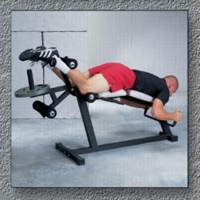 |
|
Picture 1 |
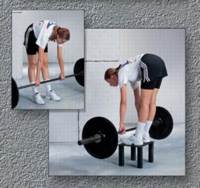 |
|
Picture 2 |
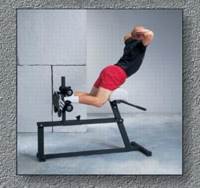 |
|
Picture 3 |
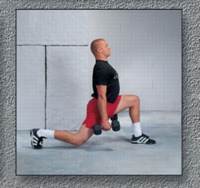 |
|
Picture 4 |
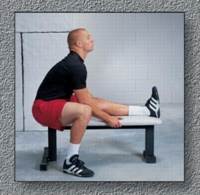 |
|
Picture 5 |
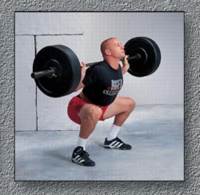 |
|
Picture 6 |
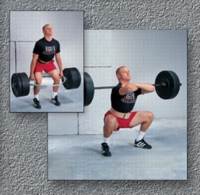 |
|
Picture 7 & 8 |